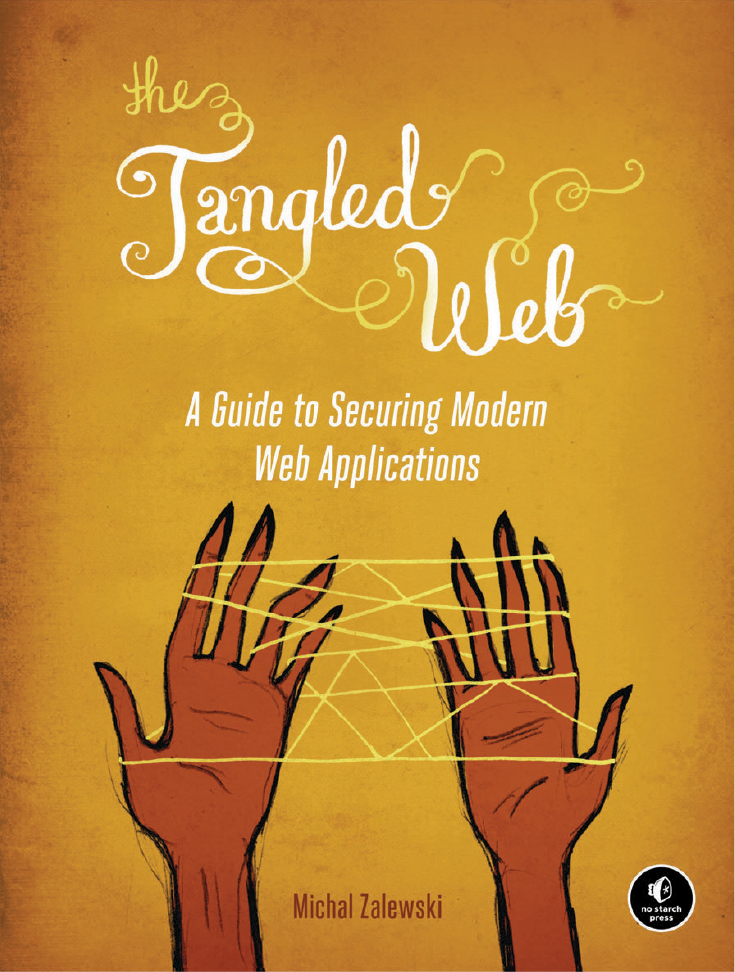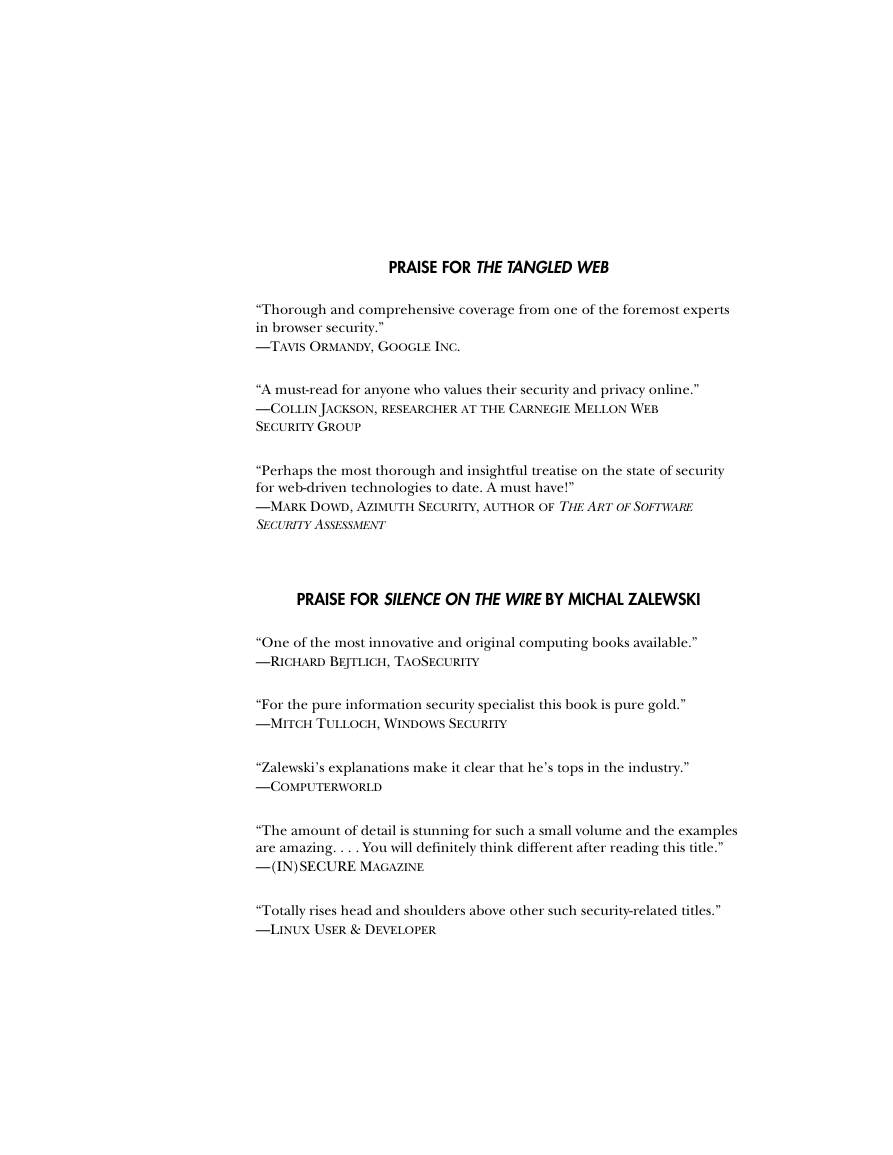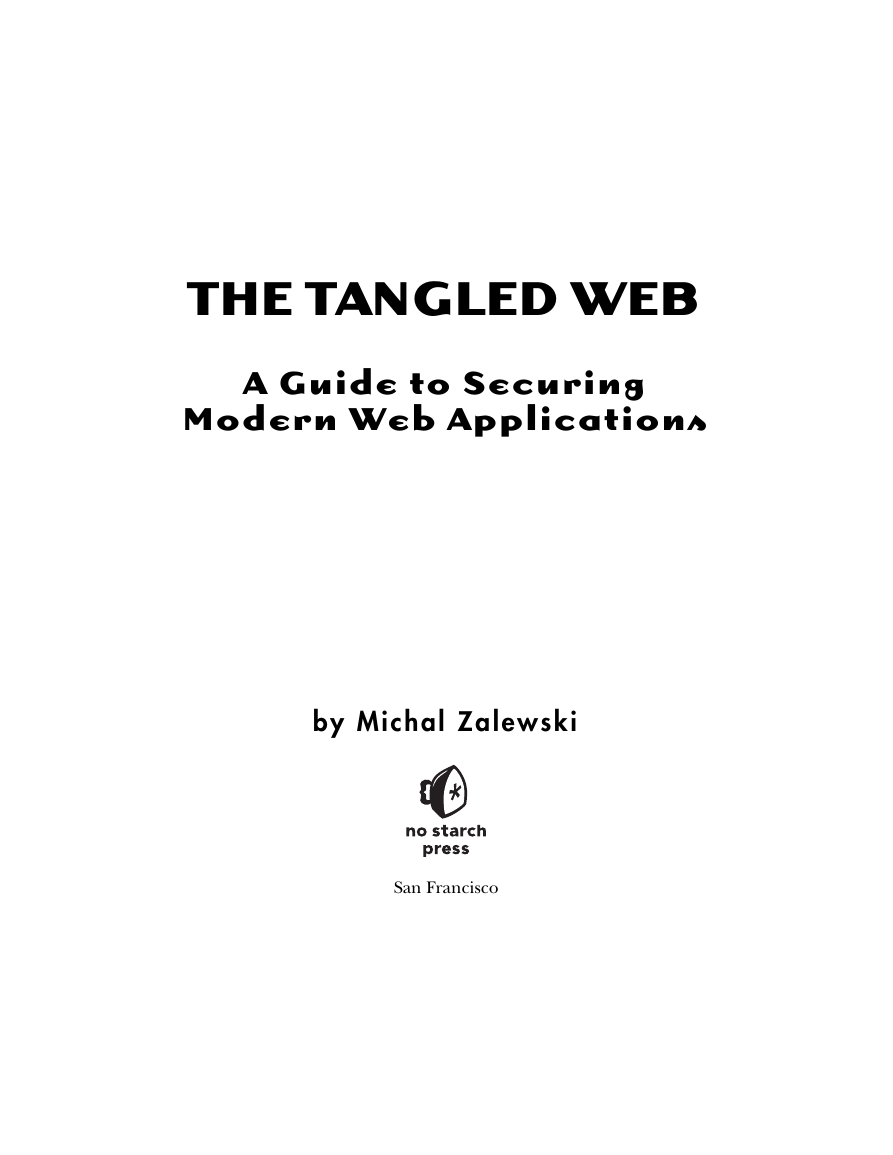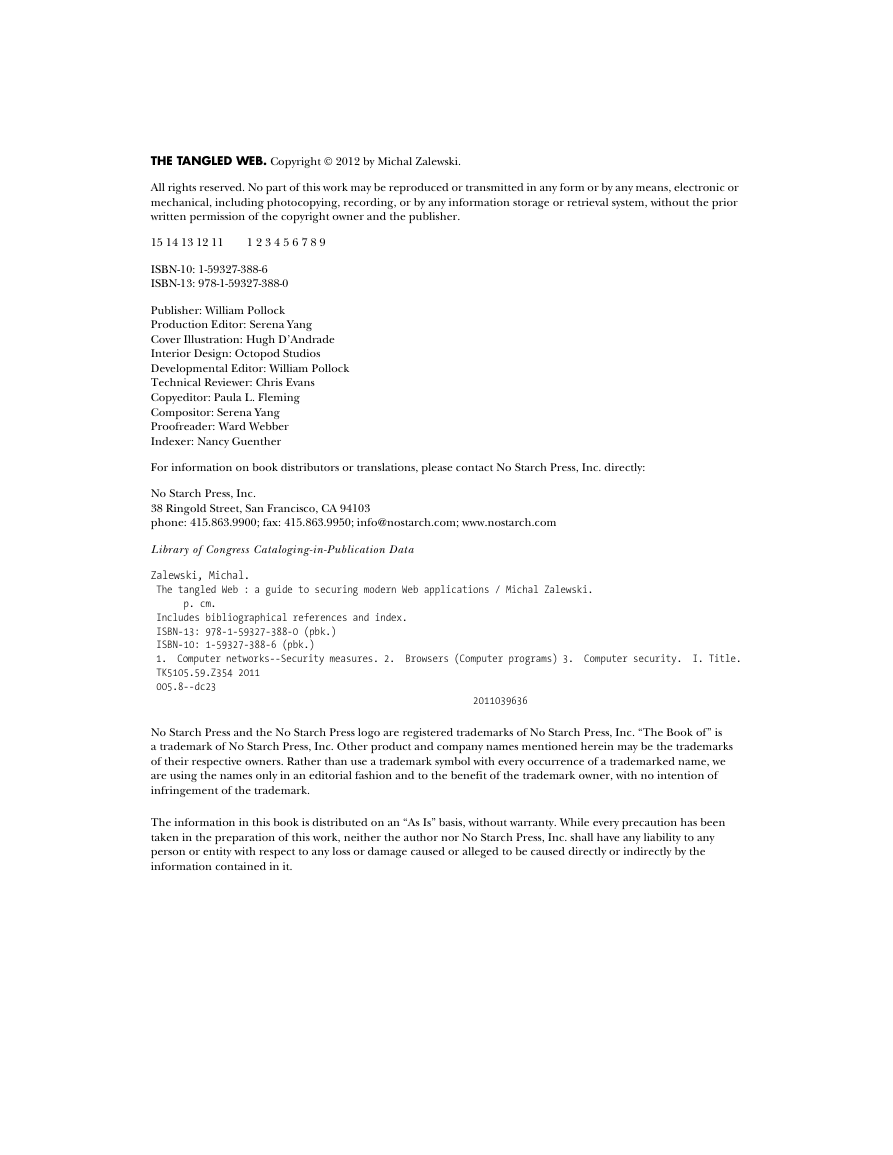Preface
Acknowledgments
1: Security in the World of Web Applications
Information Security in a Nutshell
Flirting with Formal Solutions
Enter Risk Management
Enlightenment Through Taxonomy
Toward Practical Approaches
A Brief History of the Web
Tales of the Stone Age: 1945 to 1994
The First Browser Wars: 1995 to 1999
The Boring Period: 2000 to 2003
Web 2.0 and the Second Browser Wars: 2004 and Beyond
The Evolution of a Threat
The User as a Security Flaw
The Cloud, or the Joys of Communal Living
Nonconvergence of Visions
Cross-Browser Interactions: Synergy in Failure
The Breakdown of the Client-Server Divide
Global browser market share, May 2011
PART I: Anatomy of the Web
2: It Starts with a URL
Uniform Resource Locator Structure
Scheme Name
Indicator of a Hierarchical URL
Credentials to Access the Resource
Server Address
Server Port
Hierarchical File Path
Query String
Fragment ID
Putting It All Together Again
Reserved Characters and Percent Encoding
Handling of Non-US-ASCII Text
Common URL Schemes and Their Function
Browser-Supported, Document-Fetching Protocols
Protocols Claimed by Third-Party Applications and Plug-ins
Nonencapsulating Pseudo-Protocols
Encapsulating Pseudo-Protocols
Closing Note on Scheme Detection
Resolution of Relative URLs
Security Engineering Cheat Sheet
When Constructing Brand-New URLs Based on User Input
When Designing URL Input Filters
When Decoding Parameters Received Through URLs
3: Hypertext Transfer Protocol
Basic Syntax of HTTP Traffic
The Consequences of Supporting HTTP/0.9
Newline Handling Quirks
Proxy Requests
Resolution of Duplicate or Conflicting Headers
Semicolon-Delimited Header Values
Header Character Set and Encoding Schemes
Referer Header Behavior
HTTP Request Types
GET
POST
HEAD
OPTIONS
PUT
DELETE
TRACE
CONNECT
Other HTTP Methods
Server Response Codes
200-299: Success
300-399: Redirection and Other Status Messages
400-499: Client-Side Error
500-599: Server-Side Error
Consistency of HTTP Code Signaling
Keepalive Sessions
Chunked Data Transfers
Caching Behavior
HTTP Cookie Semantics
HTTP Authentication
Protocol-Level Encryption and Client Certificates
Extended Validation Certificates
Error-Handling Rules
Security Engineering Cheat Sheet
When Handling User-Controlled Filenames in Content-Disposition Headers
When Putting User Data in HTTP Cookies
When Sending User-Controlled Location Headers
When Sending User-Controlled Redirect Headers
When Constructing Other Types of User-Controlled Requests or Responses
4: Hypertext Markup Language
Basic Concepts Behind HTML Documents
Document Parsing Modes
The Battle over Semantics
Understanding HTML Parser Behavior
Interactions Between Multiple Tags
Explicit and Implicit Conditionals
HTML Parsing Survival Tips
Entity Encoding
HTTP/HTML Integration Semantics
Hyperlinking and Content Inclusion
Plain Links
Forms and Form-Triggered Requests
Frames
Type-Specific Content Inclusion
A Note on Cross-Site Request Forgery
Security Engineering Cheat Sheet
Good Engineering Hygiene for All HTML Documents
When Generating HTML Documents with Attacker-Controlled Bits
When Converting HTML to Plaintext
When Writing a Markup Filter for User Content
5: Cascading Style Sheets
Basic CSS Syntax
Property Definitions
@ Directives and XBL Bindings
Interactions with HTML
Parser Resynchronization Risks
Character Encoding
Security Engineering Cheat Sheet
When Loading Remote Stylesheets
When Putting Attacker-Controlled Values into CSS
When Filtering User-Supplied CSS
When Allowing User-Specified Class Values on HTML Markup
6: Browser-Side Scripts
Basic Characteristics of JavaScript
Script Processing Model
Execution Ordering Control
Code and Object Inspection Capabilities
Modifying the Runtime Environment
JavaScript Object Notation and Other Data Serializations
E4X and Other Syntax Extensions
Standard Object Hierarchy
The Document Object Model
Access to Other Documents
Script Character Encoding
Code Inclusion Modes and Nesting Risks
The Living Dead: Visual Basic
Security Engineering Cheat Sheet
When Loading Remote Scripts
When Parsing JSON Received from the Server
When Putting User-Supplied Data Inside JavaScript Blocks
When Interacting with Browser Objects on the Client Side
If You Want to Allow User-Controlled Scripts on Your Page
7: Non-HTML Document Types
Plaintext Files
Bitmap Images
Audio and Video
XML-Based Documents
Generic XML View
Scalable Vector Graphics
Mathematical Markup Language
XML User Interface Language
Wireless Markup Language
RSS and Atom Feeds
A Note on Nonrenderable File Types
Security Engineering Cheat Sheet
When Hosting XML-Based Document Formats
On All Non-HTML Document Types
8: Content Rendering with Browser Plug-ins
Invoking a Plug-in
The Perils of Plug-in Content-Type Handling
Document Rendering Helpers
Plug-in-Based Application Frameworks
Adobe Flash
Microsoft Silverlight
Sun Java
XML Browser Applications (XBAP)
ActiveX Controls
Living with Other Plug-ins
Security Engineering Cheat Sheet
When Serving Plug-in-Handled Files
When Embedding Plug-in-Handled Files
If You Want to Write a New Browser Plug-in or ActiveX Component
PART II: Browser Security Features
9: Content Isolation Logic
Same-Origin Policy for the Document Object Model
document.domain
postMessage(...)
Interactions with Browser Credentials
Same-Origin Policy for XMLHttpRequest
Same-Origin Policy for Web Storage
Security Policy for Cookies
Impact of Cookies on the Same-Origin Policy
Problems with Domain Restrictions
The Unusual Danger of “localhost”
Cookies and “Legitimate” DNS Hijacking
Plug-in Security Rules
Adobe Flash
Microsoft Silverlight
Java
Coping with Ambiguous or Unexpected Origins
IP Addresses
Hostnames with Extra Periods
Non-Fully Qualified Hostnames
Local Files
Pseudo-URLs
Browser Extensions and UI
Other Uses of Origins
Security Engineering Cheat Sheet
Good Security Policy Hygiene for All Websites
When Relying on HTTP Cookies for Authentication
When Arranging Cross-Domain Communications in JavaScript
When Embedding Plug-in-Handled Active Content from Third Parties
When Hosting Your Own Plug-in-Executed Content
When Writing Browser Extensions
10: Origin Inheritance
Origin Inheritance for about:blank
Inheritance for data: URLs
Inheritance for javascript: and vbscript: URLs
A Note on Restricted Pseudo-URLs
Security Engineering Cheat Sheet
11: Life Outside Same-Origin Rules
Window and Frame Interactions
Changing the Location of Existing Documents
Unsolicited Framing
Cross-Domain Content Inclusion
A Note on Cross-Origin Subresources
Privacy-Related Side Channels
Other SOP Loopholes and Their Uses
Security Engineering Cheat Sheet
Good Security Hygiene for All Websites
When Including Cross-Domain Resources
When Arranging Cross-Domain Communications in JavaScript
12: Other Security Boundaries
Navigation to Sensitive Schemes
Access to Internal Networks
Prohibited Ports
Limitations on Third-Party Cookies
Security Engineering Cheat Sheet
When Building Web Applications on Internal Networks
When Launching Non-HTTP Services, Particularly on Nonstandard Ports
When Using Third-Party Cookies for Gadgets or Sandboxed Content
13: Content Recognition Mechanisms
Document Type Detection Logic
Malformed MIME Types
Special Content-Type Values
Unrecognized Content Type
Defensive Uses of Content-Disposition
Content Directives on Subresources
Downloaded Files and Other Non-HTTP Content
Character Set Handling
Byte Order Marks
Character Set Inheritance and Override
Markup-Controlled Charset on Subresources
Detection for Non-HTTP Files
Security Engineering Cheat Sheet
Good Security Practices for All Websites
When Generating Documents with Partly Attacker-Controlled Contents
When Hosting User-Generated Files
14:
Dealing with Rogue Scripts
Denial-of-Service Attacks
Execution Time and Memory Use Restrictions
Connection Limits
Pop-Up Filtering
Dialog Use Restrictions
Window-Positioning and Appearance Problems
Timing Attacks on User Interfaces
Security Engineering Cheat Sheet
When Permitting User-Created















